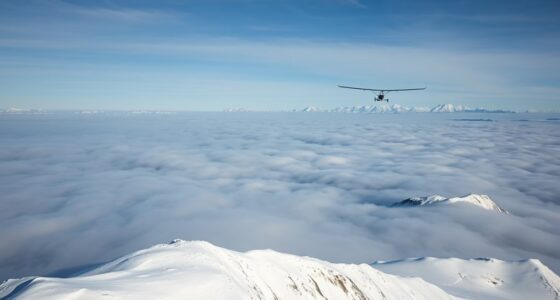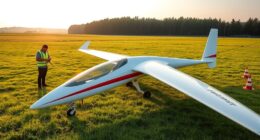In arid regions with high temperature contrasts, desert thermals form as intense surface heating creates rising columns of warm air, which gliders and birds ride to stay aloft effortlessly. You can detect these heat plumes using specialized instruments or by observing bird and glider movements. These natural updrafts turn harsh deserts into effective soaring environments, helping you extend flight times with minimal effort. If you keep exploring, you’ll discover how these incredible heat channels release endless possibilities for flight.
Key Takeaways
- Desert thermals are caused by intense surface heating, creating rising columns of warm air that enable soaring.
- Solar updrafts generate continuous heat plumes, providing reliable lift in arid regions with high temperature contrasts.
- Birds and gliders exploit these heat plumes to glide long distances with minimal energy expenditure.
- Modern technology enhances the detection and utilization of desert thermals for extended, safe soaring flights.
- High temperature differences in deserts produce powerful heat plumes, making arid environments ideal for soaring activities.

Have you ever wondered how birds and gliders soar effortlessly over endless sand dunes? One of nature’s most remarkable tricks involves harnessing desert thermals—rising columns of warm air—that provide the lift needed for flight in arid regions. These thermals are driven by the intense heat of the desert surface, creating powerful heat plumes that ascend into the sky. When the sun beats down on the barren landscape, it heats the ground unevenly, causing pockets of hot air to form. These heat plumes rise rapidly, forming the basis of thermal currents that gliders and birds exploit to stay aloft without flapping or engine power.
In deserts, solar updrafts play a vital role. They occur when the sun’s energy heats the ground, which then radiates heat upward into the atmosphere. This process generates a continuous upward flow of warm air, creating a natural, sustained thermal that can last for hours on a clear, sunny day. As the ground absorbs solar radiation, the air directly above it heats up more quickly, becoming less dense and rising swiftly. This process results in a thermal column that pilots of gliders and soaring birds can circle within, gaining altitude with minimal effort. These solar updrafts are particularly effective in desert environments because the surface temperature can reach extreme levels, sometimes exceeding 70 degrees Celsius (158 degrees Fahrenheit), producing intense heat plumes that rise high into the atmosphere.
You might be surprised to know that desert thermals are not just a challenge for pilots but also a fundamental part of the ecosystem. Birds like raptors and storks rely heavily on these thermal currents to stretch their wings and glide for miles with minimal energy expenditure. They skillfully circle within heat plumes, gaining altitude before gliding to the next thermal, essentially riding the desert’s invisible lifts. Glider pilots, too, seek out these rising columns, using instruments to locate the strongest heat plumes, allowing them to extend their flight time dramatically. The ability to exploit solar updrafts and heat plumes turns a seemingly harsh, inhospitable environment into a natural runway for soaring. Additionally, the advanced technology used in modern gliders greatly enhances the ability to detect and utilize these thermals efficiently, making flight in desert conditions more accessible and safer.
Frequently Asked Questions
How Do Desert Thermals Compare to Mountain Thermals?
Desert thermals differ from mountain thermals mainly in origin and strength. In deserts, sand dunes create sharp temperature gradients, producing strong, often unpredictable thermals that you can ride for long distances. Mountain thermals, however, form along slopes and ridges, providing steadier lift. Both rely on temperature differences, but desert thermals tend to be more intense and less predictable, making desert soaring both thrilling and challenging.
What Equipment Is Best for Desert Thermal Soaring?
For desert thermal soaring, you’ll want equipment with excellent durability to withstand harsh conditions. Use thermal visualization tools like variometers and thermal detectors to identify rising air currents accurately. Choose a sturdy, lightweight glider designed for high temperatures, and pack sun protection gear. Reliable communication devices also help, ensuring safety in remote desert areas. Prioritize gear that performs well under intense sun and heat, making your soaring experience safer and more enjoyable.
Are Desert Thermals Suitable for Beginner Gliders?
Yes, desert thermals can be suitable for beginner gliders if you understand thermal formation and thermal stability. You should start with a glider designed for easy handling and stability, as desert thermals can be unpredictable due to high temperature contrasts. Learning to identify areas with stable thermal formation helps you stay safe and improve your skills. Always fly within your limits and seek guidance from experienced pilots when exploring these conditions.
How Do Weather Changes Affect Desert Thermals?
Weather changes substantially impact desert thermals. When surface temperatures rise or fall rapidly, thermals become more unpredictable, making soaring challenging. Humidity variations also play a role; low humidity often strengthens thermals, while increased humidity can weaken them. Did you know that desert thermals can reach speeds of up to 50 knots? Staying aware of these weather shifts helps you anticipate thermal strength and plan your flight accordingly.
Can Desert Thermals Be Used for Long-Distance Flights?
Yes, you can use desert thermals for long-distance flights. Solar uplift and thermal dynamics create strong, consistent lift in arid regions, allowing you to glide for hours. By understanding how solar heating interacts with surface features, you can optimize your altitude and route. Staying aware of changing thermal conditions helps you maintain efficiency and extend your flight, making desert thermals a reliable option for cross-country soaring.
Conclusion
As you glide through desert thermals, picture yourself as a lone bird riding the fiery breath of the sun, soaring above shifting sands and shimmering heatwaves. These rising columns are like invisible bridges connecting you to the sky’s secrets, inviting you to dance with the fierce yet beautiful desert. Embrace the challenge, and let the heat’s silent song lift you higher, turning arid silence into a symphony of freedom and adventure.









